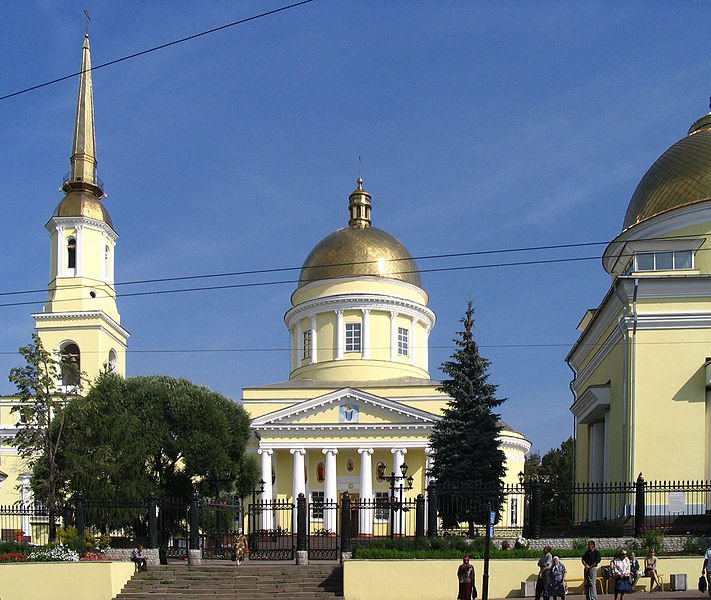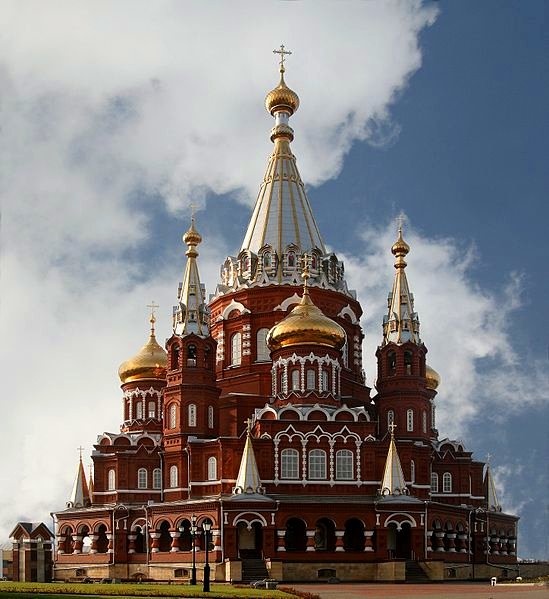 Cathedral of Saint Alexander Nevsky, Izhevsk, Russia
Cathedral of Saint Alexander Nevsky, Izhevsk, RussiaSource: https://commons.wikimedia.org/wiki/File:Orthodox_Church,_Izhevsk.jpg
Author: Unomano

Izhevsk was established by Count Peter Shuvalov in 1760 as the site of an ironworks. The town was passed over to the crown after the death of the count, in payment for his debts to the treasury. In 1774, rebels under Yemelyan Pugachev, pretender to the Russian throne, took over Izhevsk by force and executed the administrative staff of the ironworks.
In 1807, the ironworks was replaced by a munitions factory which became the mainstay of the town's economy. Among the investors to the munitions factory was Ludvig Nobel, the older brother of Alfred Nobel, who founded the Nobel Prize. Workers of the munitions factory formed a worker's soviet, or Council, in 1917.
 St Michael's Cathedral, Izhevsk
St Michael's Cathedral, IzhevskSource: https://en.wikipedia.org/wiki/File:Svyato_Mihailovsky_Cathedral_Izhevsk_Russia_Richard_Bartz-edit.jpg
Author: Richard Bartz

The Council was taken over by the Bolsheviks later that same year. The following month, the Council was dissolved with the forming of the Soviet Government, and the former leaders of the Council arrested. This led to an uprising against Bolshevik rule in Izhevsk. It ended when the Bolsheviks sent in the Red Army. The Red Army was momentarily held at bay by the anti-Communist White Army, but was eventually defeated by the Red Army in June, 1919.
Under the Soviet, Izhevsk grew to become the administrative center of the Votsk Autonomous Oblast, the precursor to present-day Udmurt Republic. In 1984, Izhevsk was renamed Ustinov. Within three years it reverted to its historical name following vocal opposition by many of its citizens.
Today Izhevsk is the economic nerve center of the Udmurt Republic. Most of the financial and industrial activities of Udmurt Republic are concentrated here. The city manufactures small arms, rifles, motorcycles and automobiles.
Visiting Izhevsk
You can fly to Izhevsk from Moscow, Saint Petersburg and Yekaterinburg. There are also trains from Moscow (18 hours), Saint Petersburg (31 hours), Yekaterinburg (11 hours), Kazan (6 hours) and Perm (10 hours).Places of Interest in Izhevsk
- Academy Choir Chapel
- Alexander Nevsky Cathedral
- Arsenal Museum
- Galeria Arts Center
- Galina Kulakova Museum
- Gennadiy Krasilnikov Apartment-Museum
- Izhevsk Circus
- Izhevsk City Pond
- Izhmash Museum
- Kalashnikov Museum
- Korolenko State Russian Theater for Drama
- National Fire Arts Gallery
- National Kuzebai Gerd Museum
- National State Theater of the Udmurt Republic
- Pesochnaya TV Mast
- Presidential Palace
- St Michael's Cathedral
- State Opera and Ballet Theater of the Udmurt Republic
- State Philharmonic of the Udmurt Republic
- State Puppet Theater of the Udmurt Republic
- Young Man Alternative Theatre
 Latest updates on Penang Travel Tips
Latest updates on Penang Travel Tips
About this website

Thanks for reading this page. My name is Timothy Tye. My hobby is to research information about places, and share the information with people on this website. I started this website on 5 January 2003, and since then, have written about over 20,000 places, mostly in Malaysia and Singapore.
Please use the information on this page as guidance only. While I try my best to provide you information that is as accurate as I can get it to be, I do apologize for any errors. Also, as I might not be able to update some information on time, some of these pages may contain outdated information.
Copyright © 2003-2024 Timothy Tye. All Rights Reserved.


 Go Back
Go Back